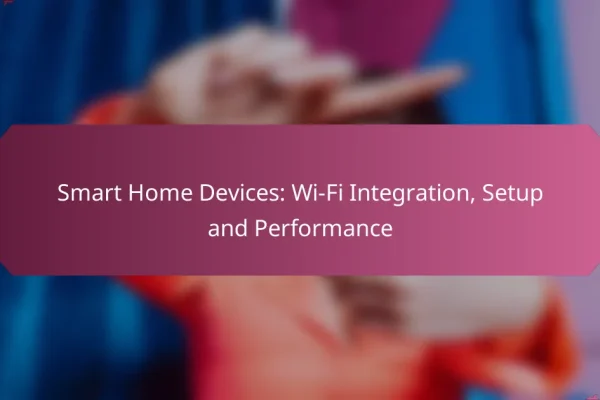How do smart home devices integrate with home automation systems?
Smart home devices integrate with home automation systems through various communication protocols that allow them to work together seamlessly. These integrations enable users to control multiple devices from a single platform, enhancing convenience and efficiency in managing home environments.
Compatibility with Z-Wave
Z-Wave is a popular wireless communication protocol designed specifically for smart home devices. It operates on a low-frequency band, which helps reduce interference from other wireless devices. Many smart home products, such as lights, locks, and sensors, are compatible with Z-Wave, allowing for easy integration into home automation systems.
When using Z-Wave, consider the range limitations, typically around 30 meters indoors. To extend coverage, you can add Z-Wave repeaters, which help maintain a strong signal throughout your home.
Integration with Zigbee
Zigbee is another widely used protocol for smart home devices, known for its low power consumption and mesh networking capabilities. This means that Zigbee devices can relay signals to one another, extending the range and reliability of your smart home network. Many smart devices, including smart bulbs and thermostats, support Zigbee integration.
When setting up Zigbee devices, ensure that you have a compatible hub, as this is essential for managing and controlling your devices effectively. Zigbee typically operates on the 2.4 GHz frequency, which may lead to interference in crowded environments.
Connection to Wi-Fi networks
Many smart home devices connect directly to Wi-Fi networks, allowing for easy access and control via smartphone apps or voice assistants. This connection enables real-time monitoring and control from anywhere with internet access. However, Wi-Fi-connected devices can consume more power and may experience latency compared to other protocols.
When using Wi-Fi for smart devices, ensure your router can handle multiple connections, as too many devices may slow down your network. Consider using a dual-band router to optimize performance for both 2.4 GHz and 5 GHz devices.
Use of Bluetooth technology
Bluetooth technology is commonly used for short-range connections between smart home devices, such as speakers and smart locks. It allows for quick pairing and control without the need for a central hub. However, Bluetooth typically has a limited range of about 10 meters, making it less suitable for larger homes.
When integrating Bluetooth devices, be aware of potential interference from other Bluetooth devices and ensure that your smartphone or control device is within range. Bluetooth can be a good option for devices that do not require constant connectivity or remote access.
What are the best smart home devices for integration?
The best smart home devices for integration typically include hubs and platforms that connect various devices seamlessly. Popular options like Amazon Echo, Google Nest Hub, Philips Hue, and SmartThings allow users to control multiple smart devices from a single interface, enhancing convenience and functionality.
Amazon Echo as a hub
The Amazon Echo serves as a central hub for many smart home devices, enabling voice control through Alexa. It supports a wide range of compatible devices, including lights, thermostats, and security cameras, allowing users to create routines and automate tasks easily.
When setting up the Echo, ensure that your devices are compatible with Alexa. You can manage settings through the Alexa app, which provides an intuitive interface for device control and integration.
Google Nest Hub features
The Google Nest Hub acts as a smart display that integrates with various Google services and compatible devices. It allows users to control smart home devices with voice commands or touch gestures, providing visual feedback and easy access to information.
Key features include the ability to view security camera feeds, control lights, and manage schedules. The Nest Hub also supports routines, which can automate multiple actions with a single command, enhancing the overall smart home experience.
Philips Hue lighting compatibility
Philips Hue smart lighting is highly compatible with various smart home ecosystems, including Amazon Alexa and Google Assistant. Users can control their lights remotely, set schedules, and create scenes that adjust the ambiance of their home.
To integrate Philips Hue, you need the Hue Bridge, which connects to your Wi-Fi network. Once set up, you can easily add and control multiple lights through compatible apps or voice commands.
SmartThings ecosystem
The SmartThings ecosystem allows users to connect and manage a wide array of smart devices from different brands. It supports devices like sensors, cameras, and appliances, providing a unified platform for home automation.
To get started with SmartThings, download the SmartThings app and create an account. From there, you can add devices, set up automations, and monitor your home environment. This flexibility makes it a popular choice for users looking to customize their smart home experience.
How to choose smart home devices for seamless integration?
Choosing smart home devices for seamless integration involves assessing compatibility, user interface, and security features. Prioritize devices that communicate well with each other and fit into your existing ecosystem for optimal performance.
Consider device compatibility
Device compatibility is crucial for ensuring that all your smart home devices work together efficiently. Look for devices that support common communication protocols like Wi-Fi, Zigbee, or Z-Wave, as these standards facilitate interaction between different brands and types of devices.
Check if the devices you are considering are compatible with your existing smart home hub or ecosystem, such as Google Home, Amazon Alexa, or Apple HomeKit. This can save you from potential integration issues down the line.
Evaluate user interface and control
The user interface of smart home devices should be intuitive and easy to navigate. Consider how you will control the devices—whether through mobile apps, voice commands, or physical remotes—and choose options that fit your lifestyle.
Test the interfaces of different devices before purchasing, if possible. A well-designed user experience can significantly enhance your interaction with the technology and make daily tasks more convenient.
Assess security features
Security features are essential when selecting smart home devices, as they can be vulnerable to hacking. Look for devices that offer strong encryption, regular firmware updates, and secure authentication methods.
Consider devices that have received positive reviews for their security measures and check for any reported vulnerabilities. Investing in devices with robust security can help protect your home network and personal data from potential threats.
What are the benefits of integrating smart home devices?
Integrating smart home devices offers numerous advantages, including improved convenience, enhanced energy efficiency, and increased security. These benefits stem from the seamless communication between devices, allowing for automation and better management of home systems.
Enhanced convenience and automation
Smart home integration simplifies daily tasks by allowing devices to work together. For example, a smart thermostat can adjust the temperature based on when you leave or return home, while smart lights can turn on automatically as you enter a room.
Automation can be customized through routines or schedules, enabling users to set specific actions at designated times. This not only saves time but also reduces the need for manual control of each device.
Energy efficiency improvements
Integrating smart home devices can lead to significant energy savings. Smart thermostats, for instance, can optimize heating and cooling schedules, potentially reducing energy bills by 10-20%. Smart plugs can monitor energy usage and help identify devices that consume excessive power.
Additionally, many smart devices can be programmed to operate during off-peak hours, further enhancing energy efficiency. This can be particularly beneficial in regions with variable electricity pricing.
Increased home security
Smart home integration enhances security through interconnected devices that can monitor and respond to threats. For example, smart cameras can send alerts to your phone if they detect unusual activity, while smart locks can be controlled remotely to grant access to trusted visitors.
Moreover, integrating security systems with other smart devices allows for automated responses, such as turning on lights when a security breach is detected. This layered approach provides peace of mind and can deter potential intruders.
What challenges exist in smart home device integration?
Smart home device integration faces several challenges that can hinder seamless operation. Key issues include interoperability, network connectivity, and security vulnerabilities, each of which can affect user experience and device performance.
Interoperability issues
Interoperability issues arise when devices from different manufacturers fail to communicate effectively. This can occur due to varying communication protocols, such as Zigbee, Z-Wave, or Wi-Fi, which may not be compatible with one another.
To mitigate interoperability challenges, consider using a smart home hub that supports multiple protocols. This can centralize control and improve compatibility among devices, allowing for a more cohesive smart home experience.
Network connectivity problems
Network connectivity problems can disrupt the functionality of smart home devices, leading to delays or failures in operation. These issues often stem from weak Wi-Fi signals, network congestion, or insufficient bandwidth.
To enhance connectivity, ensure your router is positioned centrally and consider upgrading to a mesh Wi-Fi system if your home is large. Regularly check your internet speed and bandwidth usage to maintain optimal performance for all devices.
Security vulnerabilities
Security vulnerabilities in smart home devices can expose users to potential hacking and data breaches. Many devices lack robust security features, making them attractive targets for cybercriminals.
To protect your smart home, regularly update device firmware and change default passwords to strong, unique ones. Implementing a separate network for smart devices can also help isolate them from your main network, reducing the risk of unauthorized access.
What are the future trends in smart home technology integration?
Future trends in smart home technology integration focus on enhanced interoperability, increased automation, and the growing role of artificial intelligence. As devices become more interconnected, users can expect seamless control and improved efficiency in their homes.
Growth of AI in smart homes
The integration of artificial intelligence (AI) in smart homes is transforming how devices communicate and operate. AI enables systems to learn user preferences and adapt to their routines, enhancing convenience and energy efficiency.
For example, smart thermostats can analyze past usage patterns to optimize heating and cooling schedules, potentially reducing energy costs by 10-20%. Voice-activated assistants, powered by AI, allow users to control multiple devices with simple commands, streamlining daily tasks.
To maximize the benefits of AI in smart homes, consider investing in devices that support machine learning and regular software updates. Avoid choosing products from manufacturers with limited support, as this can hinder the device’s ability to evolve and integrate with new technologies over time.









